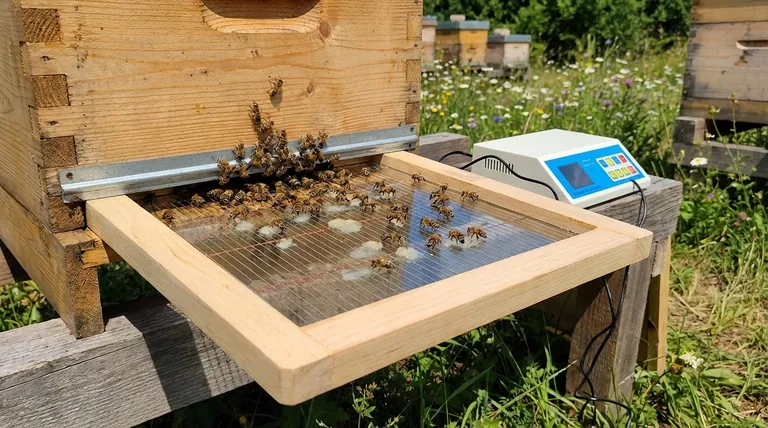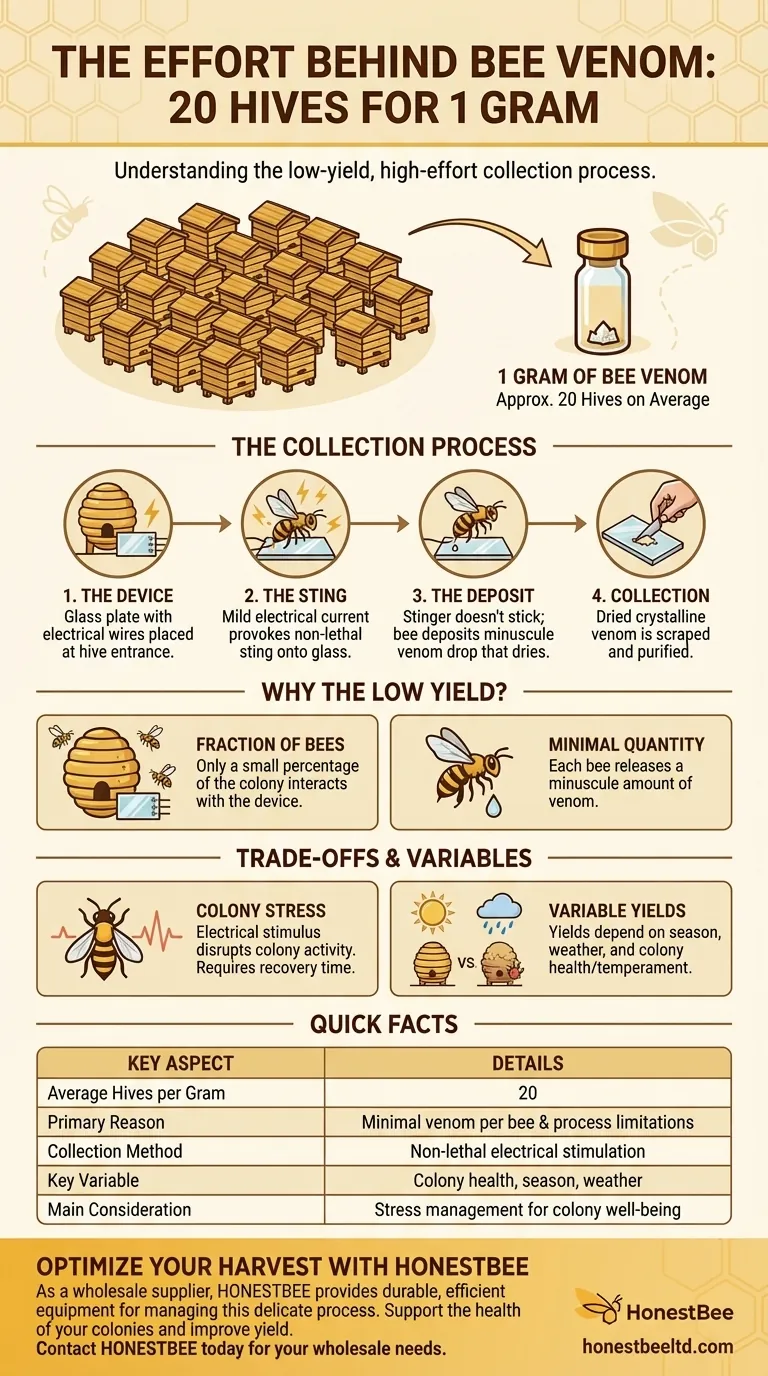On average, approximately 20 beehives are needed to collect a single gram of bee venom. This seemingly high number is due to the minuscule amount of venom each individual bee produces and the nature of the collection process.
The core takeaway is that bee venom collection is a low-yield, high-effort process. The "20 hives per gram" figure is a practical average that reflects the limitations of collection technology and the natural behavior of honeybees.

Why Is So Much Effort Required?
Understanding the "why" behind the numbers requires looking at the collection method and the biology of the honeybee. Collectors are not taking venom from every bee, but rather inducing a small number to sting a specialized device.
The Collection Device
The standard tool is a bee venom collector, which is a glass plate with a grid of wires stretched across it. This frame is often placed at the hive entrance.
A mild electrical current is passed through the wires. When bees touch the wires, they receive a small shock.
This shock doesn't harm the bee, but it provokes a defensive reaction, causing them to sting the glass plate.
The Venom Deposit
When a bee stings the smooth glass surface, its stinger does not get stuck as it would in skin. The bee can retract its stinger and fly away unharmed.
The bee deposits a tiny amount of venom onto the glass. This venom quickly dries into a crystalline substance.
Later, the collector scrapes this dried venom off the glass plate. The collected material is then purified to become the final product.
The Yield per Hive
A single hive contains thousands of bees, but only a fraction will interact with the collection device during a session.
Each bee releases a very small quantity of venom. Therefore, even with thousands of bees, the total amount collected from one hive during a single session is minimal.
This is why collectors must place devices on numerous hives—averaging around 20—to accumulate just one gram of the substance.
Understanding the Trade-offs
While the process is designed to be non-lethal, it's essential to recognize the potential impacts and variables involved.
Stress on the Colony
The collection process introduces a stressor to the hive. The electrical stimulus and induced alarm response can disrupt the colony's normal activities.
Because of this, experienced beekeepers typically run collection devices on a hive for a limited time and then allow for a recovery period before collecting from that same hive again.
Variable Yields
The "20 hives per gram" figure is a benchmark, not a fixed law. Actual yields can vary significantly based on the time of year, the health and temperament of the colony, and the weather.
A strong, active colony on a warm day will likely produce more venom than a weaker colony or one in poor weather.
Applying This to Your Understanding
This information helps frame the value and production challenges associated with bee venom.
- If your primary focus is on the economics of apitherapy: Recognize that the high labor and equipment cost for a low-yield product is the primary driver of bee venom's market price.
- If your primary focus is on beekeeping practices: Understand that venom collection is a specialized activity that requires careful management to avoid harming the long-term health of your colonies.
Ultimately, the process of collecting bee venom is a careful balance between stimulating a natural defense mechanism and ensuring the continued well-being of the honeybee colony.
Summary Table:
| Key Aspect | Details |
|---|---|
| Average Hives per Gram | 20 |
| Primary Reason | Minimal venom per bee & collection process limitations |
| Collection Method | Non-lethal electrical stimulation on a glass plate |
| Key Variable | Colony health, season, and weather conditions |
| Main Consideration | Stress management for colony well-being |
Optimize Your Bee Venom Harvesting with HONESTBEE
Understanding the high effort behind bee venom collection is the first step to improving your yield. As a wholesale supplier to commercial apiaries and distributors, HONESTBEE provides the durable, efficient beekeeping equipment you need to manage this delicate process effectively.
Let us help you equip your operation for success. Contact HONESTBEE today to discuss your wholesale equipment needs and support the health of your colonies.
Visual Guide

Related Products
- Full Set Beekeeping Electronic Bee Venom Collector Machine Device for Bee Venom Collecting
- HONESTBEE 6 Frame Three Use Electric Honey Extractor for Beekeeping
- Nicot Queen Rearing Kit for Beekeeping and Grafting in Nicot System
- HONESTBEE 3-Frame Manual Acrylic Honey Extractor
- Stainless Steel 3 Frame Manual Honey Extractor Spinner for Bee Honey Extraction
People Also Ask
- How frequently should pollen be collected for human consumption? Optimize Your Harvesting Schedule
- What method is used to collect venom from honey bees? A Guide to Modern, Non-Lethal Extraction
- How much venom can be collected from a single bee? A Microscopic Yield of Immense Value
- Where is the venom collection apparatus placed in a bee colony? Optimize Yield at the Hive Entrance
- How long is each colony of bees 'milked' for venom collection? The 5-Minute Rule for Sustainable Harvesting



















